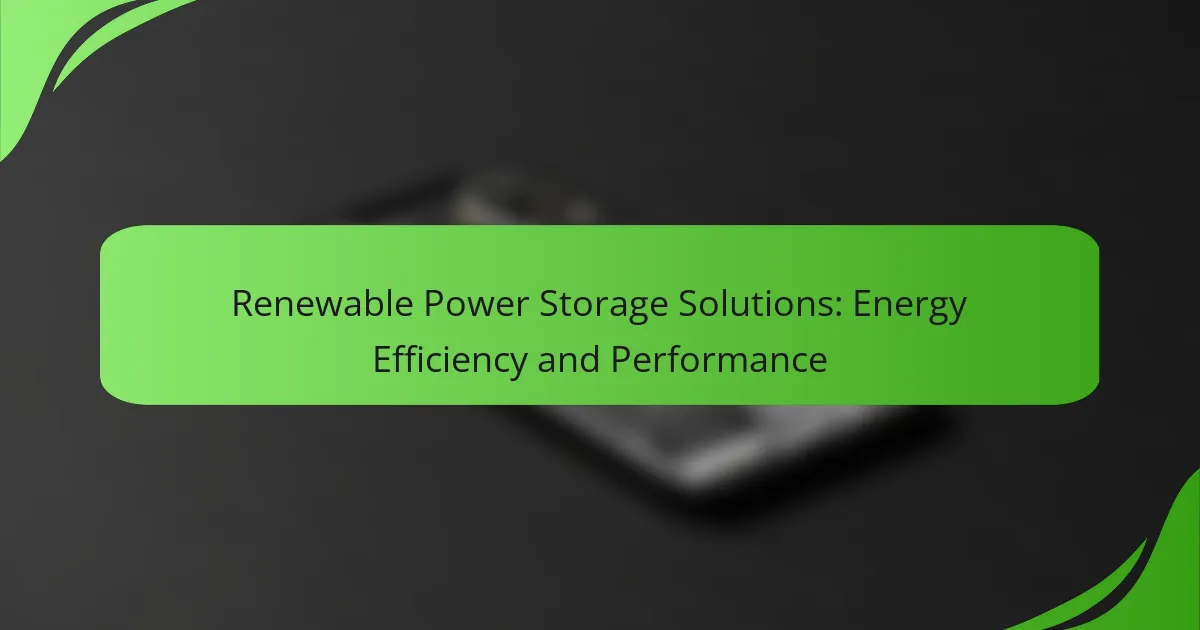Renewable power storage solutions play a crucial role in enhancing energy efficiency and performance by capturing excess energy generated during peak production times. Options such as lithium-ion batteries, flow batteries, and pumped hydro storage offer unique advantages tailored to various energy needs. By optimizing the use of renewable resources, these systems minimize waste and contribute to a more sustainable energy landscape.

What are the best renewable power storage solutions in the United States?
The best renewable power storage solutions in the United States include lithium-ion batteries, flow batteries, pumped hydro storage, compressed air energy storage, and thermal energy storage. Each option has unique characteristics, advantages, and applications that cater to different energy needs and scenarios.
Lithium-ion batteries
Lithium-ion batteries are widely used for energy storage due to their high energy density and efficiency. They are commonly found in electric vehicles and grid storage applications, providing quick response times and the ability to cycle frequently.
However, they can be expensive and have a limited lifespan, typically lasting around 5 to 15 years. When considering lithium-ion batteries, evaluate the initial investment against the expected performance and replacement costs over time.
Flow batteries
Flow batteries utilize two electrolyte solutions separated by a membrane, allowing for scalable energy storage. They are particularly advantageous for large-scale applications, as their capacity can be increased by adding more electrolyte rather than changing the battery size.
While flow batteries have a longer lifespan and can be cycled more frequently than lithium-ion batteries, they generally have lower energy density and higher upfront costs. Assess the specific energy demands and budget constraints before choosing this option.
Pumped hydro storage
Pumped hydro storage is a mature technology that uses two water reservoirs at different elevations. During low demand, excess energy is used to pump water to the upper reservoir, and during high demand, the water is released to generate electricity.
This method is highly efficient, with round-trip efficiencies often exceeding 70%. However, it requires significant geographical considerations and can have environmental impacts. Ensure that suitable sites are available before pursuing this solution.
Compressed air energy storage
Compressed air energy storage (CAES) involves compressing air in underground caverns or tanks during low energy demand and releasing it to generate electricity during peak times. This method can store large amounts of energy and is suitable for grid-scale applications.
CAES systems can be less efficient than other storage methods, with round-trip efficiencies around 50-70%. Consider the availability of suitable geological formations and the potential costs associated with infrastructure development.
Thermal energy storage
Thermal energy storage systems store excess energy in the form of heat, often using materials like water, molten salt, or concrete. This stored heat can later be converted back into electricity or used directly for heating applications.
These systems are particularly useful for integrating renewable sources like solar power. However, they may require significant space and have varying efficiencies depending on the technology used. Evaluate the specific thermal storage needs and available space when considering this option.
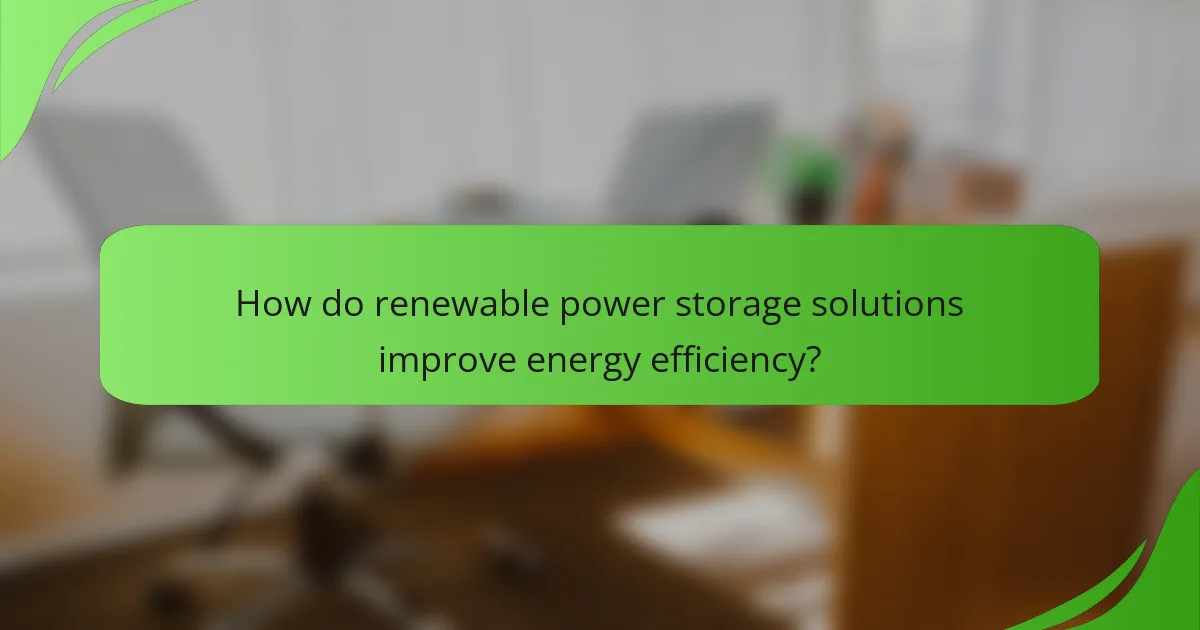
How do renewable power storage solutions improve energy efficiency?
Renewable power storage solutions enhance energy efficiency by capturing excess energy generated during peak production times and releasing it when demand is high. This process minimizes energy waste and optimizes the use of renewable resources, leading to a more sustainable energy system.
Reducing energy waste
Energy storage systems, such as batteries and pumped hydro storage, play a crucial role in reducing energy waste by storing surplus energy that would otherwise be lost. For instance, during sunny or windy days, solar panels and wind turbines can produce more energy than is needed. By storing this excess energy, facilities can utilize it later, particularly during periods of high demand or low production.
Implementing energy storage can lead to significant cost savings. Businesses and homeowners can avoid purchasing expensive peak energy from the grid, which often costs more than off-peak energy. This strategy not only reduces energy waste but also lowers electricity bills.
Enhancing grid stability
Renewable power storage solutions contribute to grid stability by providing a buffer against fluctuations in energy supply and demand. Energy storage systems can quickly release stored energy to the grid during sudden demand spikes or when renewable generation drops, helping to maintain a balanced grid.
Moreover, these systems can support frequency regulation, which is essential for the reliable operation of electrical grids. By responding to changes in frequency, storage solutions help prevent blackouts and ensure a consistent power supply, making them vital for integrating more renewable energy sources into the grid.
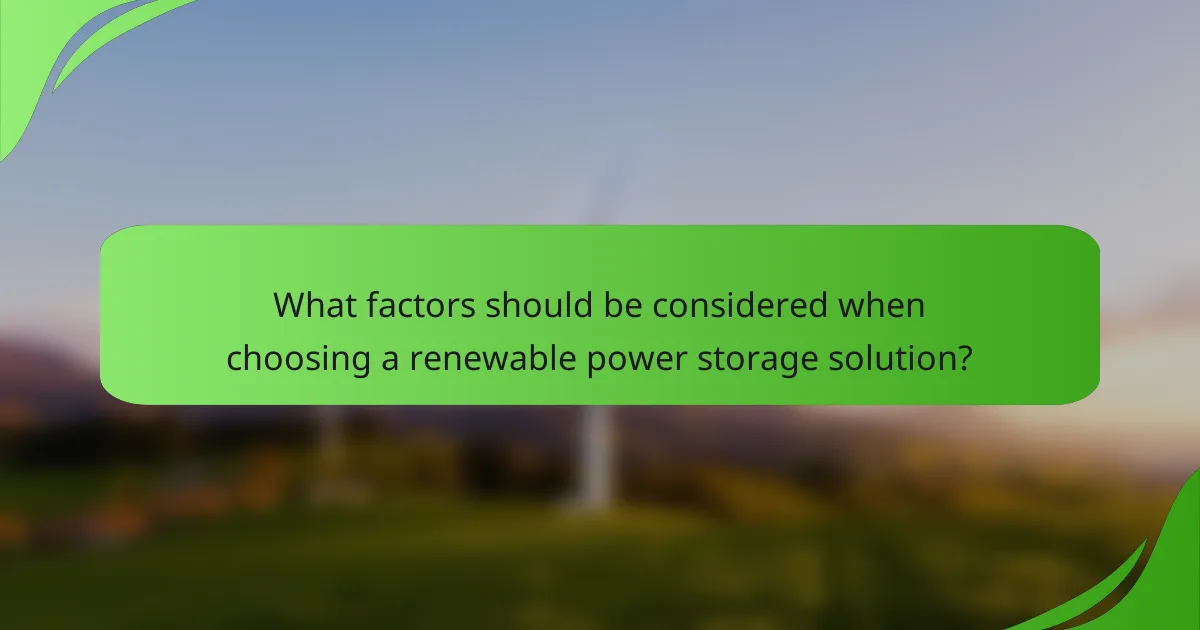
What factors should be considered when choosing a renewable power storage solution?
When selecting a renewable power storage solution, consider cost-effectiveness, capacity and scalability, and environmental impact. These factors will help you determine the best option for your energy needs and sustainability goals.
Cost-effectiveness
Cost-effectiveness is a crucial factor when evaluating renewable power storage solutions. Look for systems that provide a good balance between initial investment and long-term savings on energy bills. For instance, lithium-ion batteries may have a higher upfront cost but can offer significant savings over their lifespan.
Consider the total cost of ownership, which includes installation, maintenance, and potential incentives or rebates. In many regions, government programs may subsidize renewable energy storage, making it more affordable.
Capacity and scalability
Capacity refers to the amount of energy a storage system can hold, while scalability indicates how easily it can be expanded to meet growing energy demands. Assess your current and future energy needs to choose a system with adequate capacity.
For example, a small residential solar battery might suffice for a household, but larger commercial operations may require scalable solutions like modular battery systems. Ensure that the chosen technology can grow with your energy requirements without significant additional investment.
Environmental impact
The environmental impact of a renewable power storage solution is essential to consider, especially if sustainability is a priority. Evaluate the materials used in the storage technology and their lifecycle, including production, usage, and disposal.
For instance, while lithium-ion batteries are widely used, their production can have a significant environmental footprint. Alternatives like flow batteries or recycled battery technologies may offer lower environmental impacts. Research local recycling programs to understand how to responsibly dispose of or repurpose storage systems at the end of their life cycle.
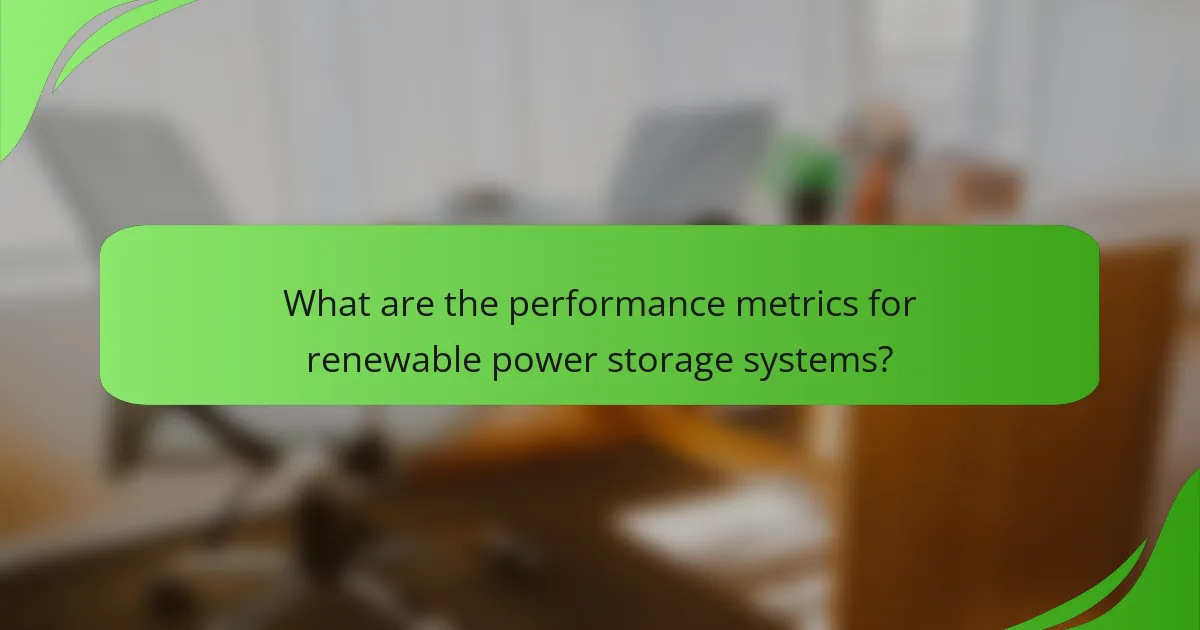
What are the performance metrics for renewable power storage systems?
The performance metrics for renewable power storage systems include round-trip efficiency, cycle life, and response time. These metrics are critical for evaluating how effectively a storage system can store and deliver energy, impacting overall energy efficiency and performance.
Round-trip efficiency
Round-trip efficiency measures how much energy is retained after it is stored and then retrieved. It is calculated by dividing the energy output by the energy input, typically expressed as a percentage. For many battery technologies, round-trip efficiency can range from 70% to over 90%, depending on the type and condition of the system.
Higher round-trip efficiency indicates better performance, as less energy is lost during the storage process. When selecting a storage system, consider both the efficiency rating and the specific use case, as some applications may prioritize efficiency over other factors.
Cycle life
Cycle life refers to the number of complete charge and discharge cycles a storage system can undergo before its capacity significantly degrades. This metric is crucial for understanding the longevity and cost-effectiveness of the system. For instance, lithium-ion batteries typically offer a cycle life of 500 to 2,000 cycles, while some advanced technologies may exceed this range.
When evaluating cycle life, consider the depth of discharge (DoD) as it affects longevity; shallower discharges generally extend cycle life. Always assess the expected cycle life in conjunction with your energy storage needs to ensure optimal performance over time.
Response time
Response time is the duration it takes for a storage system to react to a demand for energy. This metric is particularly important in applications requiring rapid energy delivery, such as grid stabilization or backup power. Response times can vary widely, from low tens of milliseconds for advanced battery systems to several minutes for traditional storage solutions.
For applications that require immediate energy supply, prioritize systems with shorter response times. Understanding the response time can help in selecting the right technology for specific energy demands, ensuring reliability and efficiency in performance.

What are the emerging trends in renewable power storage technologies?
Emerging trends in renewable power storage technologies focus on enhancing efficiency, sustainability, and integration with existing energy systems. Key developments include advancements in battery technologies, smart grid integration, and innovative recycling methods that improve the lifecycle of energy storage solutions.
Advancements in solid-state batteries
Solid-state batteries represent a significant leap forward in energy storage, offering higher energy densities and improved safety compared to traditional lithium-ion batteries. These batteries use solid electrolytes, which reduce the risk of leaks and fires, making them a safer option for large-scale applications.
Manufacturers are exploring various materials for solid-state batteries, including lithium sulfide and sodium-ion alternatives. These innovations can potentially lead to batteries that charge faster and last longer, with some estimates suggesting a lifespan of over 10 years in optimal conditions.
Integration with smart grids
Integrating renewable power storage with smart grids enhances energy management and distribution efficiency. Smart grids utilize advanced communication technologies to monitor and optimize energy flow, allowing for real-time adjustments based on demand and supply.
This integration enables better utilization of renewable sources, such as solar and wind, by storing excess energy during peak production times and releasing it during high demand. As a result, energy providers can reduce reliance on fossil fuels and improve grid stability.
Innovations in recycling and sustainability
As the demand for renewable power storage grows, so does the need for sustainable practices in battery production and disposal. Innovations in recycling technologies aim to recover valuable materials from spent batteries, reducing environmental impact and resource depletion.
Companies are developing processes to reclaim lithium, cobalt, and nickel from used batteries, which can then be reused in new battery production. This circular economy approach not only minimizes waste but also lowers the overall cost of battery materials, making renewable energy storage more economically viable.
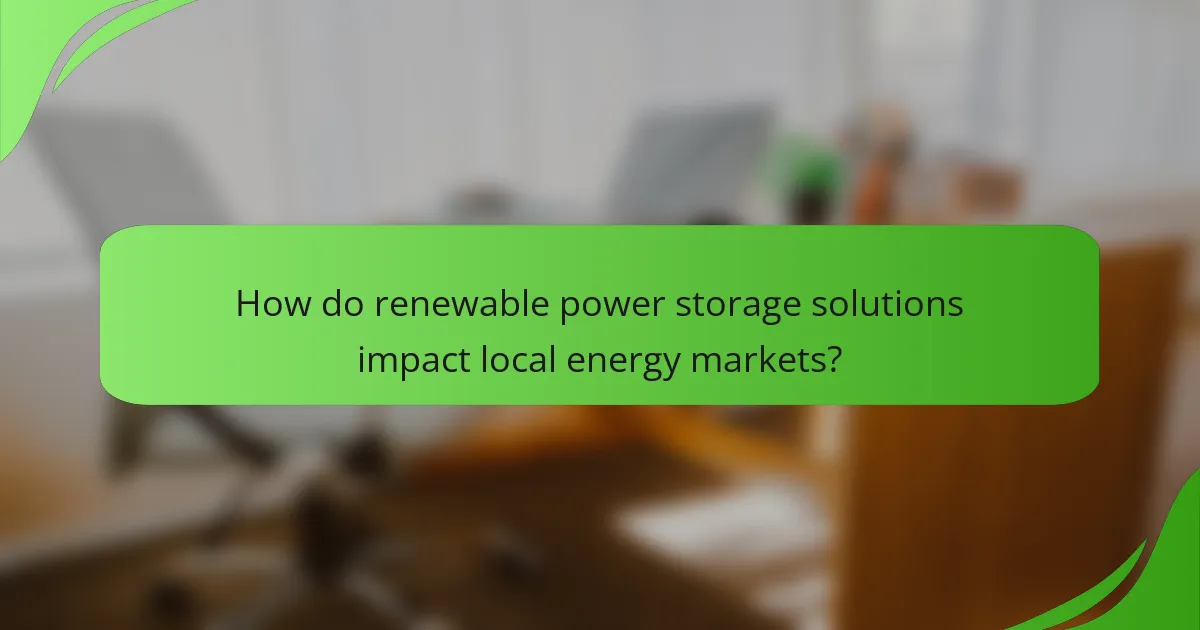
How do renewable power storage solutions impact local energy markets?
Renewable power storage solutions significantly influence local energy markets by enhancing grid stability and enabling greater integration of renewable sources. These systems allow for the storage of excess energy generated during peak production times, which can then be released during periods of high demand, thereby balancing supply and demand effectively.
Facilitating renewable energy adoption
Renewable power storage solutions play a crucial role in facilitating the adoption of renewable energy by addressing intermittency issues. For instance, solar and wind energy generation can be inconsistent, but storage systems like batteries can capture surplus energy for later use, making renewable sources more reliable.
In many regions, the implementation of energy storage can lead to reduced reliance on fossil fuels, as stored renewable energy can substitute for traditional power generation during peak hours. This transition not only supports environmental goals but can also lower energy costs for consumers in the long run.
To maximize the benefits of renewable energy adoption, stakeholders should consider investing in scalable storage technologies that align with local energy needs. Evaluating options such as lithium-ion batteries, pumped hydro storage, or emerging technologies can help determine the best fit for specific market conditions and regulatory environments.
